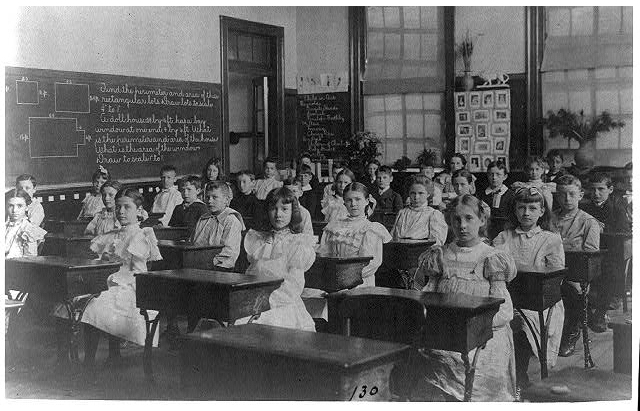School’s Out
Did you know…
With the end of summer in sight, many of us are looking forward to the fall, which means cooler weather (woohoo!) and kids going back to school. This is truly going to be an interesting year for parents, students and teachers, as we find out what the new “normal” will be for school attendance – whether that means going back to school with careful measures to lessen infection risk, attending school online, or some combination of both.
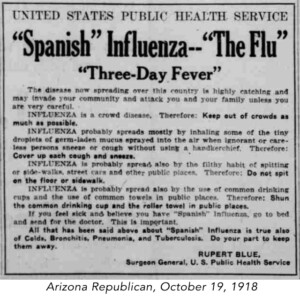 This isn’t the first time schools have been affected by illness, though. Now, things like stomach viruses and lice can get kids sent home from school or even close classrooms if need be. But, a hundred years ago and more, temporarily closing schools because of students or teachers succumbing to illness was much more common than it is today.
This isn’t the first time schools have been affected by illness, though. Now, things like stomach viruses and lice can get kids sent home from school or even close classrooms if need be. But, a hundred years ago and more, temporarily closing schools because of students or teachers succumbing to illness was much more common than it is today.
Without modern antibiotics and vaccines, getting sick with diseases like the measles, tuberculosis, cholera, meningitis, typhoid, diphtheria, and pertussis were everyday occurrences, as was dying from them. Schools would close individually as was necessary to protect their teachers and students during outbreaks. When teachers would get sick, many schools had to close because there was no one to replace them, however temporarily.
-
Fast Facts - Vaccines
- Vaccines prevent viruses like measles, tuberculosis, smallpox, influenza, and (thankfully!) COVID-19.
- The earliest vaccine was for smallpox, and was developed in 1796 by British doctor, Edward Jenner.
- During the Revolutionary War, then-General George Washington said that smallpox had the potential to be a greater threat than his enemies’ swords. He quarantined the sick, and instituted the policy that new recruits would be given a smallpox inoculation immediately when they enlisted. (We would tell you exactly how, but it was seriously icky, so you’ll have to read it for yourselves in this article if you’re interested.)
- The April 19, 1879 edition of The Phoenix Herald advertises that Dr. R.L. Rosson has vaccines in his office of the Phoenix Hotel. It doesn’t say what kind.
- During World War I, US soldiers were given smallpox and typhoid inoculations, but influenza (which didn’t yet have an effective vaccine) would kill almost half of all soldiers lost during the war – approximately 45,000 succumbed to the influenza epidemic, while over 53,000 were lost in combat.
- In 2014, the CDC estimated that childhood vaccinations prevented more than 21 million hospitalizations and 732,000 deaths among children born in the 20 years prior.
Looking online through Arizona newspapers from the turn-of-the-century, measles outbreaks commonly forced communities to close schools. Graham County schools closed for three weeks in 1899 because of the measles. Liberty Elementary in Phoenix closed from December 15, 1910 until the first of the year due to a measles outbreak. And schools in and around Pinedale, AZ closed early in May 1916 for the same reason. Around the same times, schools were closing off and on due to: Outbreaks of meningitis, scarlet fever, and smallpox; because of flooding or other weather events; but also sometimes due to a lack of qualified teachers and/or lack of proper funding.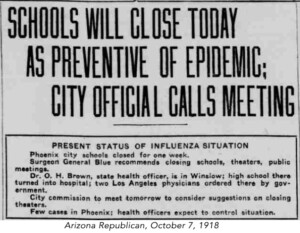
The big closures, of course, came in 1918 with the influenza outbreak. The first known cases were discovered early in the year in Haskell County, Kansas, and movement of US troops around the country and overseas extended the spread. By September 20th, the US Surgeon General requested Arizona’s Health Officer to report all known and suspected cases of influenza to the federal authorities. Seventeen days later, all Phoenix schools were closed. Though some high schools students did participate in school through the mail beginning in November, schools remained closed until December 30th. On January 6, 1919, they closed again and stayed that way until January 27th.
-
1918 State Board of Health Influenza Guidelines
The State Board of Health released these influenza guidelines in November 1918, which, like today, some people followed better than others –
The State Board of Health will give permission to the local health officer to allow the opening of schools, churches, theatres, etc., in any community where the following precautions have been taken (providing the epidemic has sufficiently subsided):
- There must be a universal, thorough cleanup of streets, alleys, yards and other places needing same. This must include a general survey against flies and fly breeding places.
- A thorough scrubbing with hot water and soap or other approved method of cleaning, of floors, walls, chairs (backs and arms especially), and other furniture, doors, door jambs, door knobs, etc., of all buildings, schools, churches, theatres and other places where public meetings are held.
- Posters must be printed and distributed and attached to houses where influenza patients are.
- Conspicuous posters must be put prominently in all public places, calling attention to the dangers of coughing, sneezing, spitting, handshaking, and kissing, the use of dishes, glasses and other tableware which have not been thoroughly washed in hot water since their previous use.
- Inspection must be made by competent persons appointed by the local health officer to ascertain if the food and drinking places are giving proper attention to the washing of their dishes and glasses, and other utensils used the preparation and serving of food and drink.
- Receptacles must be placed upon the streets at such places and in such numbers to serve as sputum basins. (EW!) If deemed best they may serve to gather other refuse. A prominent sign should be over each receptacle, calling attention to the necessity of spitting in the receptacle and not upon the sidewalk or street or other inappropriate place.
- An effort must be made to induce everybody to take the influenza vaccine. That which we have developed here in Phoenix seems to be the best. This effort must be honest, serious and systematic. Teams should be developed for the purpose of a systematic canvass of the town and other districts affected, urging everybody to take at least three injections of the vaccine.
- When satisfactory evidence has been presented to the State Board of Health, that all these seven things have been done in the spirit in which they should be, and the number of cases of influenza has sufficiently decreased, permission may be obtained for opening up churches, schools, theatres, etc.
– STATE BOARD OF HEALTH
(Yes, you read #7 correctly – they did have experimental vaccines at that time for this strain of influenza, though medical historians think they were only slightly effective on the secondary infections brought on by the virus, but not on the virus itself.)
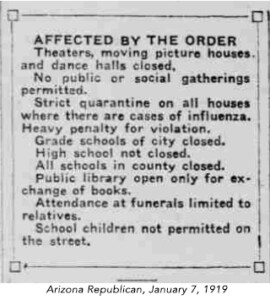 Throughout Arizona, schools closed as the virus hit their communities, as did churches, “moving picture houses”, pool halls, and public meetings. Effects of the virus forced the State Attorney General to allow married women to teach in Arizona schools for the first time beginning in October 1918. Tucson schools closed on October 10th, and Pima County as a whole did the same on October 23rd. Schools in Safford, AZ were closed from October 11, 1918 through February 10, 1919. Schools in Verde Valley had to close again in March 1919 as a recurrence of influenza sickened their community.
Throughout Arizona, schools closed as the virus hit their communities, as did churches, “moving picture houses”, pool halls, and public meetings. Effects of the virus forced the State Attorney General to allow married women to teach in Arizona schools for the first time beginning in October 1918. Tucson schools closed on October 10th, and Pima County as a whole did the same on October 23rd. Schools in Safford, AZ were closed from October 11, 1918 through February 10, 1919. Schools in Verde Valley had to close again in March 1919 as a recurrence of influenza sickened their community.
It’s comforting, in a way, to know that we’re not the first people to go through times like these, and that there are others now who are going through it with us. Thank you for your support for Heritage Square and our staff during this time – it makes a world of difference to have you here!
-
Masks and More
- Did you know, if you look up the word “mask” in Arizona newspapers throughout 1918-19, you find references to gas masks, influenza masks, masked parties, and masked bandits! It’s an interesting combination…
- In the fall of 1918, the Phoenix Board of Health requisitioned all confiscated whiskey (Prohibition had been in effect for over three years by this time), and gave it to physicians who then prescribed it to their influenza patients. An article in the Winslow Mail that December claimed it was their right to have “the Phoenix treatment,” too!
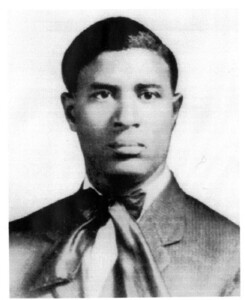
Inventor Garret Morgan
- The WWI gas mask was based on a “safety hood” designed by African American inventor, Garrett Morgan. He made his version for firefighters, allowing them to breathe safely in the presence of toxic fumes and smoke.
- Because of the use of poison gas during the war, even horses and dogs were given gas masks. (pictures below)
- Back home, families made homemade influenza masks for their cats (family pictures from Atlas Obscura.).
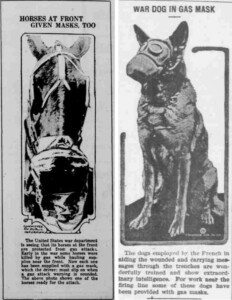
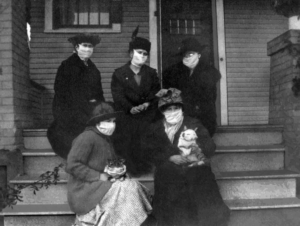
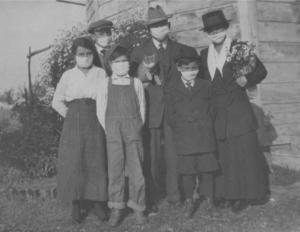
Learn more about schools in early Phoenix by reading our blog article from September 2019, and about how the 1918 influenza epidemic affected the movie industry (and more!) by reading our August 2021 blog, Moving Pictures.
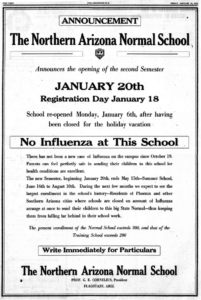 Research for this article was done through the Arizona Memory Project and Library of Congress Chronicling America. We used information from the Phoenix Tribune, Arizona Republican, Graham Guardian, Mohave County Miner, Snowflake Herald, Coolidge Examiner, The Winslow Mail, Daily AZ Silver Belt, Bisbee Daily Review, Tombstone Epitaph, The Daily Morning Oasis (Nogales), Weekly Journal-Miner, the Coconino Weekly Sun, the Arizona Champion, and the Arizona Sentinel. (whew!)
Research for this article was done through the Arizona Memory Project and Library of Congress Chronicling America. We used information from the Phoenix Tribune, Arizona Republican, Graham Guardian, Mohave County Miner, Snowflake Herald, Coolidge Examiner, The Winslow Mail, Daily AZ Silver Belt, Bisbee Daily Review, Tombstone Epitaph, The Daily Morning Oasis (Nogales), Weekly Journal-Miner, the Coconino Weekly Sun, the Arizona Champion, and the Arizona Sentinel. (whew!)
-
How to Help Heritage Square during the Pandemic
Though we’ve recently been able to reopen the Museum, over the last year our organization has struggled to have enough income to keep our employees on our payroll. The Paycheck Protection Program loan we received has allowed us to do so for a period of time, as have the grants we’ve received. As we look for other avenues of support, here’s what can you do to help keep history alive at Heritage Square:
- Write your representatives and senators. Tell them that funding nonprofit arts and culture organizations is a priority!
- Donate. Even if it’s $10. Because small donations can come together to have a big impact.
- Become a Member. Members get extra benefits the general public does not, and your membership dollars support our programs, exhibits and events. It’s a win/win!
- Shop our online Museum Store. We sell unique items that you won’t find at a big box store, and your purchase supports not only Heritage Square, but also local artists and crafters.
- Write a letter to the editor. The more our community knows we need help, the better.
Thank you!
Archive
-
2025
-
January (1)
-
-
2024
-
December (1)
-
November (1)
-
October (1)
-
September (1)
-
August (1)
-
July (1)
-
June (1)
-
May (1)
-
April (1)
-
March (1)
-
February (1)
-
January (1)
-
-
2023
-
December (1)
-
November (1)
-
October (1)
-
September (1)
-
August (1)
-
July (1)
-
June (1)
-
May (1)
-
April (1)
-
March (1)
-
February (1)
-
January (1)
-
-
2022
-
December (1)
-
November (1)
-
October (1)
-
September (1)
-
August (1)
-
July (1)
-
June (1)
-
May (1)
-
April (1)
-
-
2021
-
December (1)
-
November (1)
-
October (1)
-
September (1)
-
August (1)
-
July (1)
-
June (1)
-
May (1)
-
April (1)
-
March (1)
-
February (1)
-
January (1)
-
-
2020
-
December (1)
-
November (1)
-
October (1)
-
September (1)
-
August (1)
-
July (1)
-
June (1)
-
May (1)
-
April (1)
-
March (1)
-
February (1)
-
January (1)
-
-
2019
-
December (1)
-
November (1)
-
October (1)
-
September (1)
-
August (1)
-
July (1)
-
June (1)
-
May (1)
-
April (1)
-
March (1)
-
February (1)
-
January (1)
-
-
2018
-
December (1)
-
November (1)
-
October (1)
-
September (1)
-
August (1)
-
July (1)
-
May (1)
-
April (1)
-
March (1)
-
February (1)
-
January (1)
-
-
2017
-
December (1)
-
November (1)
-
October (1)
-
September (1)
-
August (1)
-
July (1)
-
June (1)
-
May (1)
-
April (1)
-
March (1)
-
February (1)
-
-
2016
-
December (1)
-
-
2015
-
2014
-
July (1)
-
